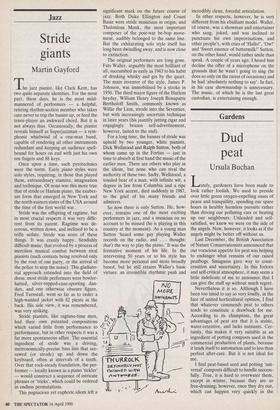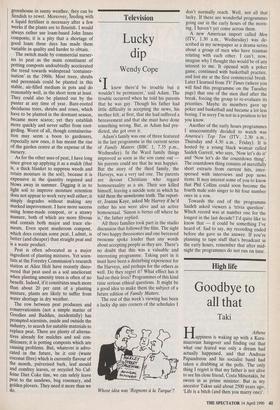Gardens
Dud peat
Ursula Buchan
Lately, gardeners have been made to look rather foolish. We used to preside over little green oxygen-expelling oases of peace and tranquillity, spending our spare hours in healthy harmless pursuits rather than driving our polluting cars or beating up our neighbours. Unleaded and self- satisfied, we knew we were on the side of the angels. Now, however, it looks as if the angels might be better off without us.
Last December, the British Association of Nature Conservationists announced that our voracious appetite for peat was helping to endanger what remains of our raised peatbogs. Smugness gave way to const- ernation and uncertainty. In this forlorn and self-critical atmosphere, it may seem a little indelicate of me to announce that I can give' the stuff up without much regret.
Nevertheless it is so. Although I have been too timid to say so very loudly, in the face of united horticultural opinion, I find that whatever commends peat to others tends to constitute a drawback for me. According to its champions, the great advantages of peat are that it is stable, water-retentive, and lacks nutrients. Cer- tainly, this makes it very suitable as an ingredient of potting composts used in the commercial production of plants, because it lends itself to automation and to less than perfect after-care. But it is not ideal for me.
I find peat-based seed and potting 'uni- versal' composts difficult to handle success- fully. True, it is hard to overwater them, except in winter, because they are so free-draining; however, once they dry out, which can happen very quickly in the greenhouse in sunny weather, they can be fiendish to rewet. Moreover, feeding with a liquid fertiliser is necessary after a few weeks if the plants are to flourish. I would always rather use loam-based John Innes composts; it is a pity that a shortage of good loam these days has made them variable in quality and harder to obtain.
The switch made by commercial nurser- ies to peat as the main constituent of potting composts undoubtedly accelerated the trend towards widespread 'container- isation' in the 1960s. Most trees, shrubs and perennials could be planted in this stable, air-filled medium in pots and do reasonably well, in the short term at least. They could also be planted out by the punter at any time of year. Bare-rooted deciduous trees, shrubs and roses, which have to be planted in the dormant season, became more scarce; yet they establish more quickly and never suffer from root- girding. Worst of all, though containerisa- tion may seem a boon to gardeners, especially new ones, it has meant the rise of the garden centre at the expense of the nursery.
As for the other uses of peat, I have long since given up applying it as a mulch (that Is, a thick blanket to suppress weeds and retain moisture in the soil), because it is expensive in the quantity required and blows away in summer. Digging it in to light soil to improve moisture retention does not appear to work very well either; it simply degrades without making any marked improvement. I have more success using home-made compost, or a strawy manure, both of which are more fibrous and contain both major and trace ele- ments. Even spent mushroom compost, which does contain some peat, I admit, is better (and cheaper) than straight peat and is a waste product.
Peat is often advocated as a major ingredient of planting mixtures. Yet scien- tists at the Forestry Commission's research station at Alice Holt have recently disco- vered that peat used as a soil ameliorant when planting amenity trees is often of no benefit. Indeed, if it constitutes much more than about 20 per cent of a planting mixture, plants are likely to suffer from water shortage in dry weather.
The row between peat producers and conservationists (not a simple matter of Goodies and Baddies, incidentally) has prompted scientists, inside and outside the industry, to search for suitable materials to replace peat. There are plenty of alterna- tives already for mulches and soil con- ditioners; it is potting composts which are causing problems. But, whatever is advo- cated in the future, be it coir (waste coconut fibre) which is currently flavour of the month, pulverised bark, leaf mould and comfrey leaves, or recycled No Caf- feine Diet Coke tins, we can safely leave peat to the sundews, bog rosemary, and golden plovers. They need it more than we do.



















































 Previous page
Previous page